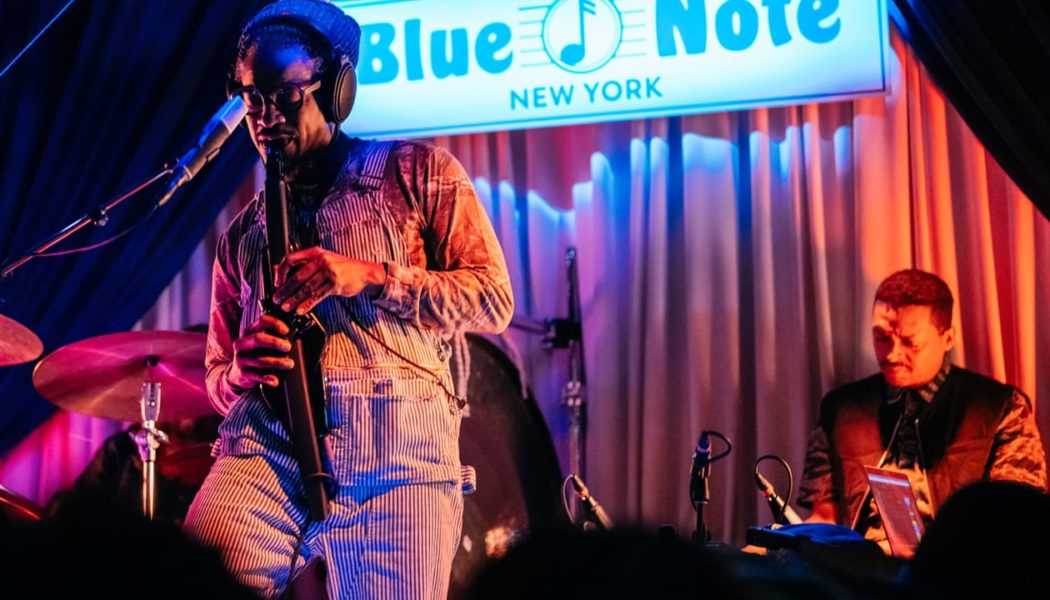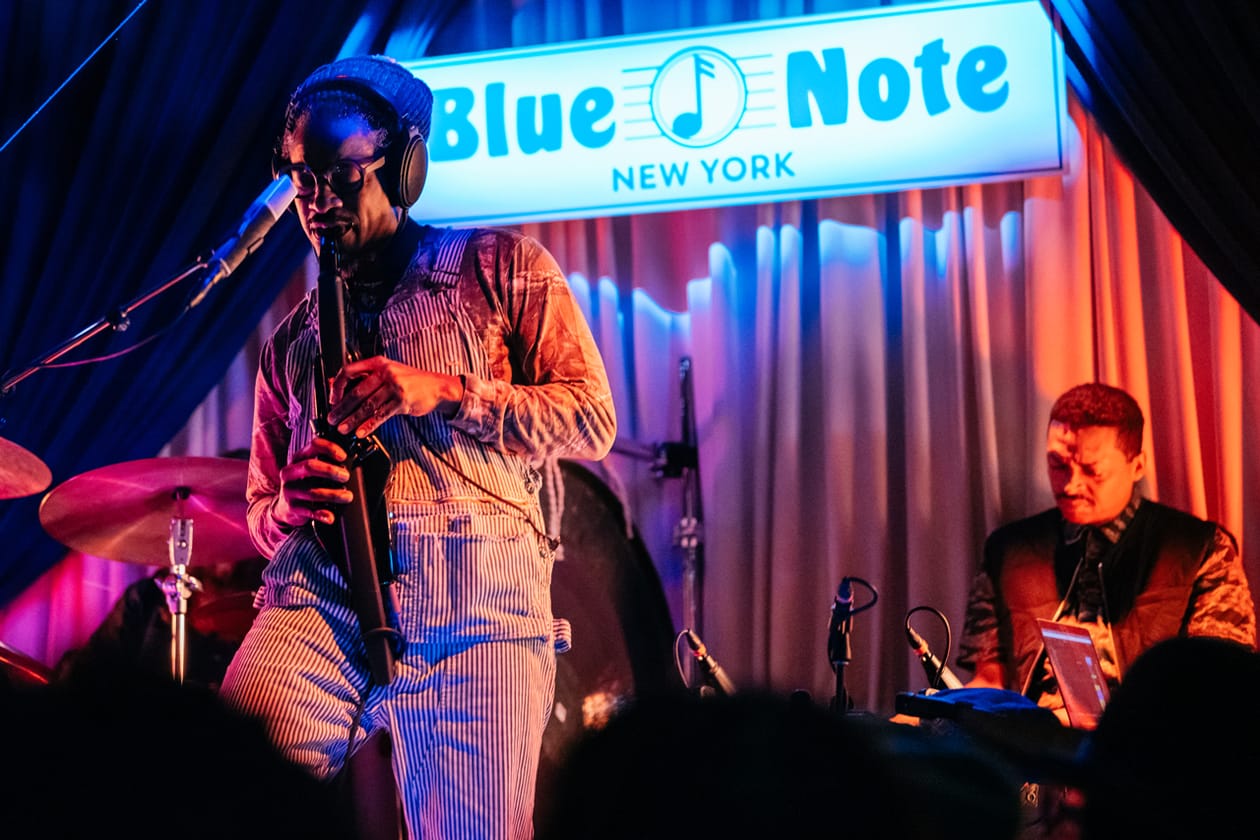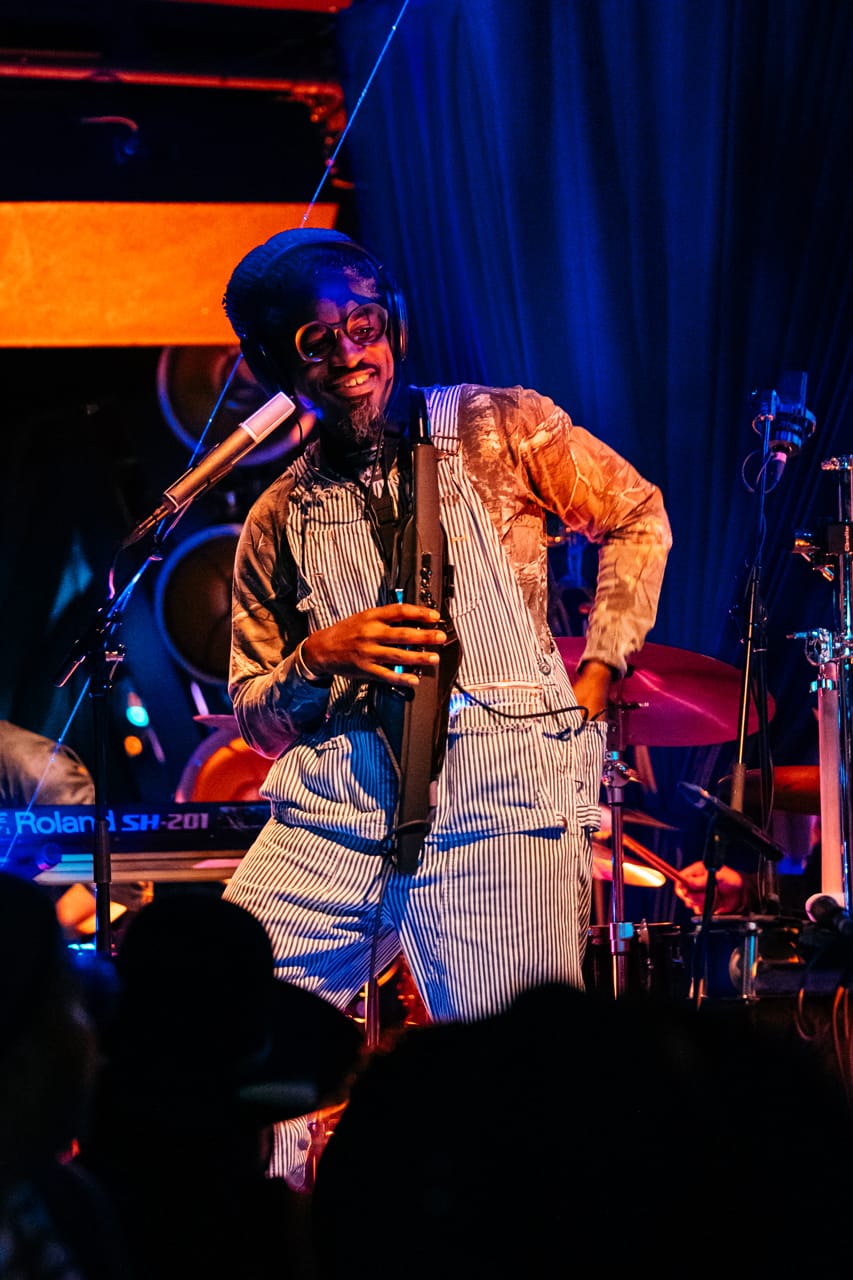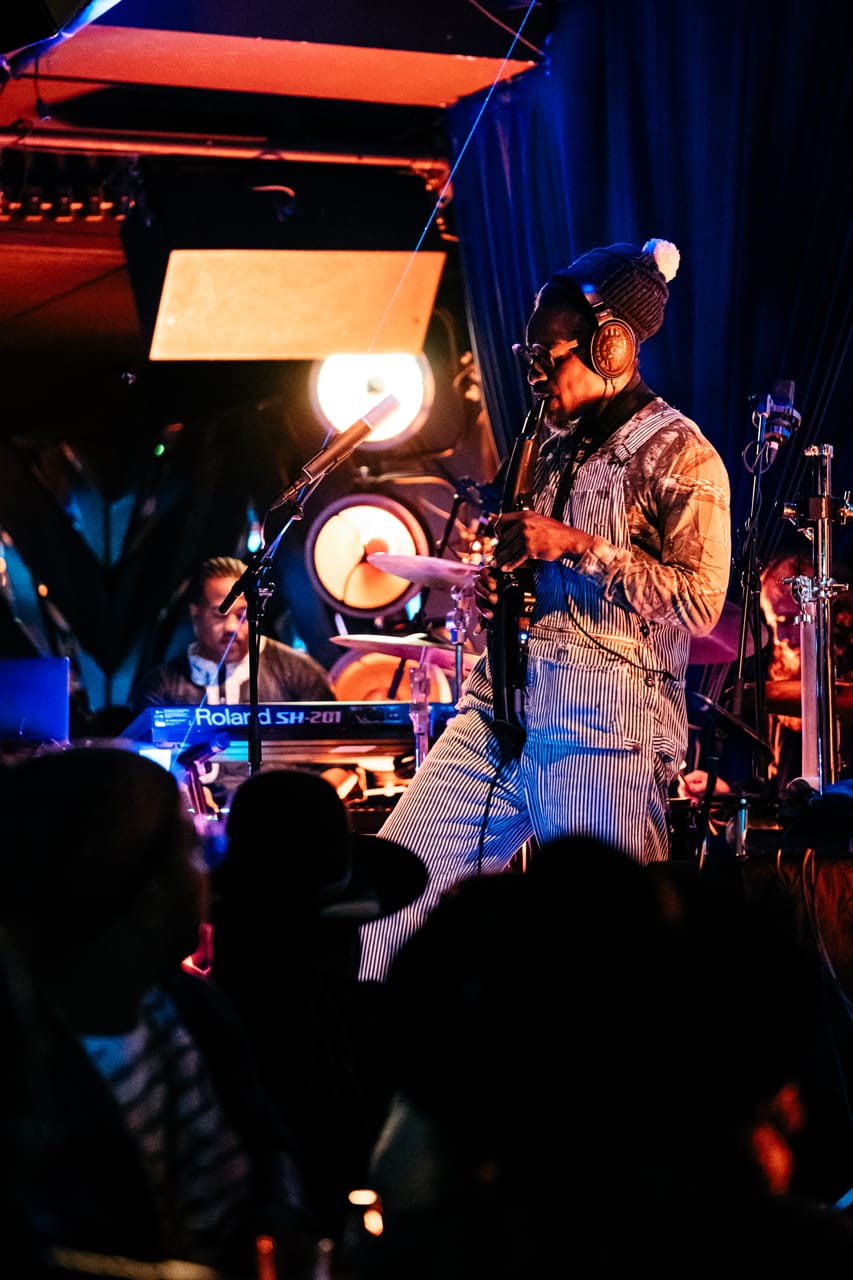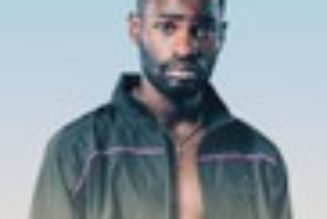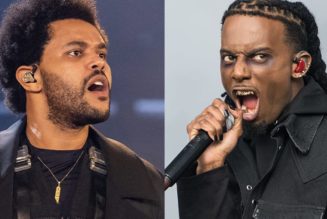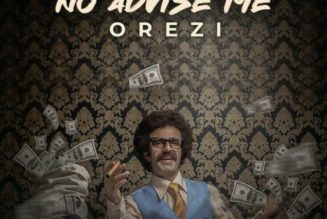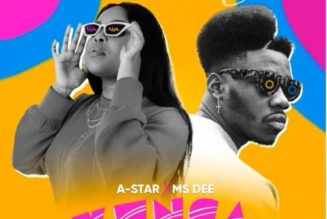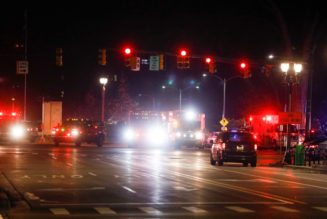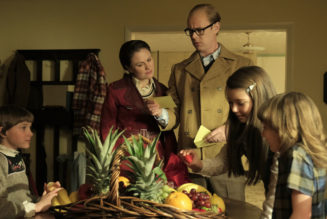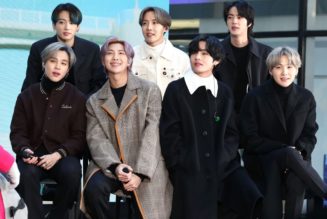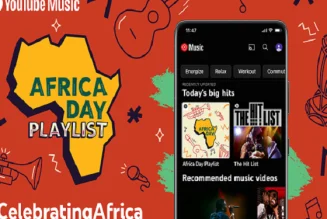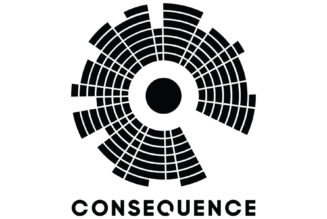“The spirit of [this music] is making stuff up and having fun,” André 3000 said to a rapt audience the Blue Note Jazz Club that included Questlove, G-Eazy and Jerrod Carmichael, phones tucked away in locked pouches, $125 per seat paid for the privilege of attending and all attention trained on the stage. “When you stop having fun, you’re in trouble.”
The enigmatic artist was in the middle of his second show in a three-night, six-show “no bars, no phones” residency at the Manhattan jazz institution, tucked off the West 4th Street stop in Greenwich Village. Taking the cramped, softly-lit stage at the intimate, 246-capacity venue placed Three Stacks, as his fans call him, in the company of past and present Blue Note performers like Dizzy Gillespie, Oscar Peterson and Robert Glasper — titans of jazz who’ve helped shape and define the music’s ever-evolving form.
André’s on tour and playing at the Blue Note in support of his solo debut New Blue Sun, an ambient, ethereal and mysterious woodwind-based album that’s a bold new addition to the new age, jazz and ambient music canons. New Blue Sun is the type of record that’s so richly layered — though it’s reasonable to infer influences from Pharaoh Sanders, Phillip Glass and Hiroshi Yoshimura — that it practically makes music journalists froth at the mouth trying to come up with the most convoluted and grandiose way to describe its sound possible. For André, describing the sound is somewhat simple; however, it’s one of discovery.
“The discovery is the energy,” he said at one point during his 90-minute set. “The way we play these tracks tonight … they’re never gonna sound the same ever again.”
This statement rang true even for devout New Blue Sun fans. Accompanied by percussionist and producer Carlos Niño, whose famed jam sessions served as the genesis of the album, keyboardist Surya Botofasina (who André gleefuly noted grew up on Alice Coltrane’s ashram), guitarist Nate Mercereau and drummer Deantoni Parks, André played a handful of recognizable melodies from tracks like “That Night in Hawaii When I Turned into a Panther and Started Making These Low Register Purring Tones That I Couldn’t Control … Sh¥t Was Wild” and “I Swear, I Really Wanted to Make a ‘Rap’ Album but This Is Literally the Way the Wind Blew Me This Time” on his EWI (electric wind instrument), but the musicians wasted no time heading deep into the waters of abstract improvisation. Though most songs would begin with a familiar melody, the quintet would never return home to the original idea to mark a clear-cut ending, instead sprawling in whatever direction the wind blew them before stopping when they seemed satisfied. If you closed your eyes and immersed yourself in the music, it felt like a childhood dream of flying through space.
There were no less than 15 flutes lying at André’s feet. And although the EWI was used the most, his heavily-reverbed microphone also broadcast the sounds of his familiar fang-adorned Mayan flute as well as the enormous, rich, bassy flute he holds on the cover of New Blue Sun. The latter being a thin, tiny flute that looked somewhat like a Slim Jim and sounded like what one would if it was able to emit noise, an ocarina-style flute and even a strange black-and-silver apparatus that André revealed was part of a bagpipe. “The guys and I went to a music store around the corner and I got this before the show,” he said. After about 30 seconds of playing, he paused. “I’m gonna keep it,” he said, to a roar from the crowd.
Though this kind of noodling doesn’t always provoke a positive reaction, the sincerity and openness in André’s experimentations enabled him to pull it off without pandering to the audience. He’s been playing the flute for under a decade and even mentioned that he’s “not a flautist” — a refrain he’s repeated in previous interviews and talk show appearances — at one point during the performance, his innate feel for harmony as well as his thoughtful melodies (it never seemed like he was playing too much) carried him through.
André and his arsenal of flutes may have been front and center, both literally and figuratively, but the performance was a true group effort. Carlos Niño’s inventive percussion was the most impressive musical feat of the night, as with a bass drum, half a dozen symbols and a gong, he created a frame of hypnotic sounds for André, Botofasina, Mercereau and Parks to fill in. Ambient music isn’t often thought of as particularly “active” — it isn’t Charlie Parker peppering eardrums with a staccato attack — and is more about creating a soundscape than virtuosic soloing, but nevertheless Niño was in near-constant motion. Besides using mallets to get lasting echos from his drum, gong and cymbals, he had an array of knick-knacks strewn at his feet that he used to create all kinds of small-but-potent sounds, from maracas that he’d tap against the rim of his drum to an array of shells that he’d cradle like a baby for a soft shaking noise and an elongated plastic tube he’d wave over his head to create a slight “wooshing” effect that was hardly picked up by the microphones.
The cadence of a New Blue Sun performance is, obviously, very different than one of the rap shows André performed as part of Outkast. In between songs he’d take brief set breaks to tell stories, as is the jazz tradition, from the familiar (how he and Niño met at a Venice Beach Erewhon) to the unheard. One tale that got a particularly warm response from the Big Apple audience was how a young André, growing up in Atlanta, would go to a different school every year, and used to tell his classmates that he was from New York City — even having a specific block, 133rd Street, ready to go so they wouldn’t pull his card. Though André, one of music’s great recluses, clearly wants New Blue Sun performances to be about listening to the music, not paying attention to him (hence the locked phone policy), his storytelling both humanized and grounded the astral atmosphere of the evening.
André was so beloved that even the occasional snafu, from a finicky mic to a handful of dry tones to admitting that he didn’t know how to pronounce Botofasina’s name to an end-of-set query about how much time was remaining were met with adulation. “All the time in the world, Three Stacks!” an excited audience member shouted in response to his query. After all, André is a man who’s currently in a position to do exactly what he wants to do with no external roadblocks; one who’s set aside a legendary rap career because it wasn’t making him happy or feel creatively fulfilled to pursue playing woodwinds, which does make him feel content and creatively fulfilled. The palpable joy caused by that creative freedom was practically radiating off of André, and served as a powerful aphrodisiac for the audience, no phones necessary.
At the end of the night, André made a statement in a twisting, turning, rapidly-spoken language, then noted that music reminded him of being a kid because of the endless room for imagination it provided, and that the language he was speaking in wasn’t a “real” one — it was one called “Kuiko” that he and his mother had made up when he was a child.
That language was an apt metaphor for the performance. As André, Niño and the band departed the stage when their set came to a close, even if you didn’t fully understand what was going on (like the tourist in the next seat over from this reporter, in town from Seoul and crestfallen that André didn’t rap despite the “no bars” note on both the album and the tour’s Cactus Plant Flea Market-designed merch) you couldn’t help but be awed by the power and impact of imagination, and how it could be communicated through music.
